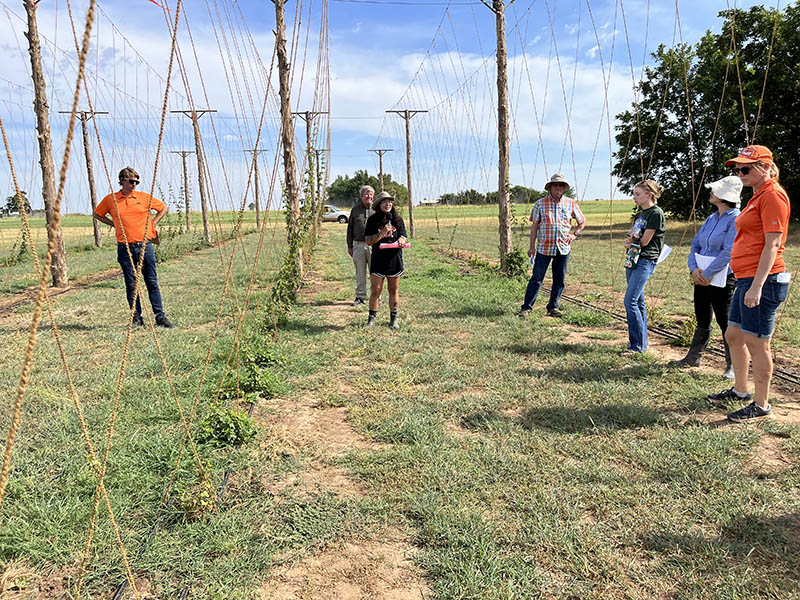Fri, 09 Sep 2022 08:13:35 CDT
American Farmers & Ranchers (AFR) Cooperative delegates are looking forward to an effective week on Capitol Hill as they participate in the 2022 National Farmers Union (NFU) Fall Legislative Fly-In Sept. 11-…

Sep 09
Fri, 09 Sep 2022 08:13:35 CDT
American Farmers & Ranchers (AFR) Cooperative delegates are looking forward to an effective week on Capitol Hill as they participate in the 2022 National Farmers Union (NFU) Fall Legislative Fly-In Sept. 11-…
Sep 09
Fri, 09 Sep 2022 08:07:17 CDT
Click here:
Growth Energy CEO Emily Skor released the following statement in response to a Reuters article that recycles highly misleading claims about ethanol’s climate benefits based on a widely…
Sep 09
Fri, 27 Jan 2023 07:26:12 CST

RON’s Dave Lanning has a pre-opening look at today’s agricultural Markets.
Click the audio tab below for today’s report.
Sep 09
Fri, 09 Sep 2022 03:21:29 CDT
Woodward Livestock Auction
Thu Sep 8, 2022
AUCTION
This Week 4,474
Last Reported &nbs…
Sep 08
Thu, 08 Sep 2022 15:29:44 CDT
The U.S. Department of Agriculture and the Oklahoma Department of Agriculture are now putting the Daily Cash Grain Report into a PDF format – we are saving that PDF and archiving them for today’s specific report. To see today’s update, click on the PDF report link at the bottom of this story.
In addition to the PDF of the daily report, you can also listen to the Cash Grain Report by calling 405-621-5533. Push 2 for the grain report.
Sep 08
Thu, 08 Sep 2022 14:31:50 CDT

Listen to today’s report with Justin Lewis, by clicking or tapping on the LISTEN bar
Sep 08
Thu, 08 Sep 2022 13:59:43 CDT
U.S. beef exports again topped $1 billion in July and posted the fifth-largest volume on record, according to data released by USDA and compiled by the U.S. Meat Export Federation (USMEF). Pork exports remai…
Sep 08
Thu, 08 Sep 2022 13:16:09 CDT
Below is an opinion piece by USCA Director Brett Crosby:
A blog post published by the U.S. Chamber of Commerce on July 12, 2022, claimed that Congress is “rushing” to consider “aggressive legislation to regulate beef markets.”
Boy, if only that were true.
In February 2020, the U.S. Cattlemen’s Association (USCA) hosted its annual Cattle Producer’s Forum at the Public Auction Yards in Billings, Montana. It was there that a group of producers discussed the idea of reigniting a concept previously advanced by Senator Chuck Grassley of Iowa to improve the cash cattle market.
That concept was introduced by Iowa’s senior senator in 2002 as the Transparency for Independent Livestock Producers Act. It would require 25 percent of a packer’s daily kill to come as a result of purchases made on the daily, open market or spot market.
That was 20 years ago.
Since that time, we’ve seen a 75% decrease in the number of cattle feedlots – from 55,472 in 2002 to 13,379 in 2017 according to U.S. Census of Agriculture data. We’ve also lost approximately 1,200 cow-calf producers and backgrounders each year.
“Rushing” into legislation? While we continue to hem and haw over whether or not bold Congressional action is needed, independent producers will exit the business.
From an outsider’s view, it can certainly seem like all this talk of consolidation and anticompetitive practices in the U.S. beef and cattle industries suddenly sprung up. But USCA and other stakeholders have worked towards restoring leverage and true price discovery in the cattle marketplace for decades. Congressional passage of the Cattle Price Discovery and Transparency Act and the Meat and Poultry Special Investigator Act represents a significant step toward achieving that goal.
In testimony to the U.S. Senate Committee on Agriculture, Nutrition, and Forestry, Dr. Stephen Koontz of Colorado State University observed that, “There are no other industries outside of cattle and beef…that work in their entirety in this type of setting – whereby supply decisions, demand revelation, and changing the product form are in distinctly different industries. Coordinating the system is difficult.”
“Difficult” is certainly understated, but the point remains: The U.S. cattle and beef industries’ marketing process and dynamics are entirely unique. In our business, we need a referee to ensure a competitive playing field free from interference. We also need a healthy and viable cash market to keep our independent producers in business.
Not many have accused Congress of moving too quickly. Democracy is designed to be a slow, laborious process. Momentum for these two historic pieces of legislation grew over nearly two years from an idea conceived by a small group of from concerned producers to widespread support from producers and consumers, grassroots organizations, Members of Congress, and the White House. Now it’s time to finish what Senator Grassley began twenty years ago: Set aside the interests of multinational meatpackers and secure the future of our sovereign food system.
Brett Crosby currently serves as Region IV Director for the U.S. Cattlemen’s Association, representing Utah, Wyoming, and Colorado.
Sep 08
Thu, 08 Sep 2022 13:11:35 CDT
Today, twelve agricultural organizations sent a letter to President Biden requesting a seat at the table during the White House Conference on Hunger, Nutrition, and Health. Since the White House launched the…
Sep 08
Thu, 08 Sep 2022 11:26:47 CDT

Oklahoma State University just kicked off its football season with a change to one of football’s biggest staples.
Beer.
Last month, Stillwater’s Iron Monk Brewing Company released a beer called 1890 Original, a crisp blonde ale brewed for OSU Cowboys, which is now the official craft beer offered at OSU football games.
But what fans inside Boone Pickens Stadium don’t know is that the university has had a long relationship with craft beer.
“People like to go out and buy local beer because they can be in the place where it was brewed,” said Charles Fontanier, associate professor, in the OSU Department of Horticulture and Landscape Architecture. “If a business can have a beer that is 100% Oklahoma ingredients, that elevates the whole industry to be able to say that. OSU Ag Research and Extension can help facilitate a connection between brewers and potential producers to help create that market and an interest in it.”
Five years ago, Bruce Dunn, a professor in the horticulture and landscape architecture department, decided to throw hops into his greenhouse mix because he had some extra space.
“It grew well but was attacked by spider mites, so I took it out to The Botanic Garden at OSU, and I was surprised to see it did really well there,” Dunn said. “One year, I harvested a trash bag full of a few different varieties, and I took that bag to Iron Monk, and they said they would see what they could do with it. A couple of weeks later, they called me and said they had made a batch with it.”
Armed with the knowledge that hops could do well in both greenhouse and field environments, Dunn approached Fontanier.
“What I really wanted to see was if we could grow better yields or higher quality plants in a greenhouse compared to field production,” Dunn said.
Fontanier said to their knowledge, OSU is one of only three hops growers in Oklahoma – a number he, Dunn and doctoral student Katie Stenmark want to change.
“The specific goal is to verify that quality hops can be grown in Oklahoma and to select the cultivars that grow best here, so we can create a local source of hops for Oklahoma craft breweries,” said Stenmark, who is working on the project for her dissertation.
Oklahoma brewers have access to the other three main ingredients in beer production: water, grain and yeast.
“We have all three of those in Oklahoma, but what we do not have is a local source of hops,” Stenmark said. “So, with the growing industry we have, it would be nice to see Oklahoma have that specialty crop.”
Stenmark, who works for Iron Monk, said when the brewery opened its doors in 2015, it was one of five craft breweries in Oklahoma. Now, there are over 67 craft breweries in the state.
“This would be a very high value crop for an Oklahoma grower to be informed about,” Stenmark said.
And gathering information is the entire goal of the hops research project.
Stenmark said the idea began with a three-year survey asking Oklahoma craft brewery professionals what cultivars of hops they would be interested in seeing grown in Oklahoma. Researchers then selected cultivars based on early to mid- and late-season ripening as well as specific aromatic qualities and essential oil profiles.
The in-field project is growing eight varieties of hops, and three of them show strong potential. Three of the greenhouse project’s five varieties are growing well and two are not, Dunn said. The greenhouse project goal is to get both a fall and spring harvest.
“At this point, we are taking visual information on what the hops cones are doing,” Fontanier said. “There shouldn’t be any discrepancies between what a variety of hops smells like and looks like in Oklahoma compared to the Pacific Northwest, but we want to verify that.”
Stenmark said for the in-field project, she and her team are studying the maintenance style of the hops trellis, the height of the canopy and the number of cones grown, as well as identifying the timing and sequence of how they grow. They will study what it takes to harvest the crops, and the quality of the crops will be analyzed in a laboratory setting.
“There has become a very high demand for the product of craft beer,” Stenmark said. “It would be good to see a lot more OSU Extension fact sheets come out of this project, so that interested growers can have information on what it would take physically and financially to grow this crop. We want to make this as feasible as possible for Oklahoma growers.”
OSU Ag Research is Oklahoma’s premier research and technology development agency in agriculture, natural resources and the life sciences.